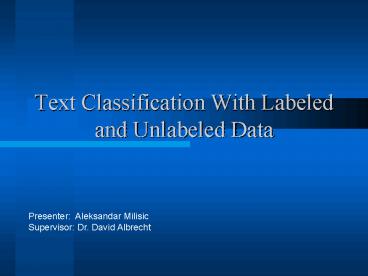Text Classification With Labeled and Unlabeled Data PowerPoint PPT Presentation
1 / 17
Title: Text Classification With Labeled and Unlabeled Data
1
Text Classification With Labeled and Unlabeled
Data
Presenter Aleksandar Milisic Supervisor Dr.
David Albrecht
2
Overview
- Text Classification What and Why?
- Text Clustering
- Support Vector Machines (SVMs) with Cluster
Features - Course of Project
- Results
- Conclusion
- Future Work
3
Text Classification What and Why?
- Text Classification assigning documents to
predefined classes (categories) - Labeling manually is time-consuming and sometimes
impossible the process needs to be automated - To minimize labeling, automated text classifiers
need to be able to utilize unlabeled data
4
How Does It Work?
- Text documents are represented using feature
vectors - Documents (both labeled and unlabeled) are
clustered into similar groups - - features representing relationship to created
- clusters are added to the feature vectors
- The augmented feature vectors are then classified
by a Support Vector Machine (SVM) (Raskutti et
al, 2002) - This novel approach was the basis of this project
5
Representing Text
With paperless offices becoming more common,
companies start using document databases with
classification schemes
Feature Vector
6
Clustering
Feature Vectors
Labeled feature vectors Unlabeled feature vectors
7
SVMs With Cluster Features
Added
Features
Labeled feature vectors (Class 1) Labeled feature
vectors (Not Class 1) Unlabeled feature
vectors Support Vectors Separating Hyperplane
8
Augmented Feature Vector
Added Features
Original Word Frequencies
- Examples of added features
- - binary closest cluster indicator
- - similarity to cluster centroids etc.
9
Areas of Investigation
- Investigated the following questions
- The value of added cluster features
- Performance of different clustering algorithms
- - Single-Pass (Raskutti et al.,
2002) - - Snob (Wallace and Boulton, 1968)
- Transductive Support Vector Machines (TSVMs)
with - clustering
- Different factors influencing performance
- - type of features, number of
clusters etc.
10
Course of Project
- Implemented Single-Pass clustering algorithm and
tested with SVMs - - using variations on number and type
of features added - Combined Snob with SVMs
- - using different attribute types
- Tested the approaches on two different data sets
- - with random splits containing 1, 5 and 10
labeled data out of the whole training set
11
Initial Results
- Initial results showed that adding cluster
features - actually degrades SVM performance.
- Various slightly modified versions of the
Single-Pass - clustering algorithm as well as Snob were
tested, all - giving negative results when combined with
SVMs. - However, one approach showed an improvement . .
.
12
Partitioning the Data
- Training set is divided into k partitions with
each - partition being clustered separately
- - features added to documents relative to k
sets of - clusters
- - k partitions means k x number of cluster
- features
- - used k 5 in experiments
13
Results
- Average number of bits for test set of size 600
Labeled Data
14
Results (cont.)
- Average number of bits for test set of size 3299
Labeled Data
15
Conclusion
- Results suggest that performance of SVMs depends
on - - number of features
- - type of features
- - clustering method
- Partitioning the data
- - improves the quality of the
features - - improves overall performance
- Issues with use of Snob and clustering in general
in text classification
16
Future Work
- Extending the SVMCluster approach to
multi-labeled - classification
- Investigating new sets of cluster features
- Determining
- - optimal number of clusters used for
adding cluster - features
- - optimal number of partitions
- Investigating better methods of using Snob in
text - classification
17
References
- Raskutti, B., Ferra, H. and Kowalczyk, A.
(2002). - Using Unlabeled Data for Text
Classification - through Addition of Cluster Parameters,
In - International Conference on Machine
Learning - (Accepted)
- Wallace C.S. and Boulton, D.M., An Information
- Measure for Classification, Computer
Journal, - Vol.11, No.2, 1968, pp 185-194

